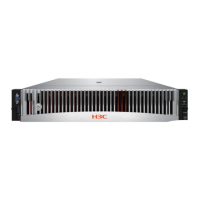37
Table 17 DIMM rank classification label description
1 Capacity
Options include:
• 8GB.
• 16GB.
• 32GB.
•
.
2 Number of ranks
Options include:
• 1R— One rank (Single-Rank).
• 2R—Two ranks (Dual-Rank). A 2R DIMM is equivalent
to two 1R DIMMs.
• 4R—Four ranks (Quad-Rank).
equivalent to two 2R DIMMs
• 8R—Eight ranks (8-Rank). An 8R DIMM is equivalent
to two 4R DIMMs.
3 Data width
Options include:
• ×4—4 bits.
• ×8—8 bits.
4 DIMM generation DDR5
5 Data rate
4800
indicates 4800 MHz.
6 DIMM type
Options include:
• L—LRDIMM.
•
—RDIMM.
Guidelines
The server provides eight DIMM channels per processor and each channel has two DIMM slots. If
the server has one processor, the total number of DIMM slots is 16. If the server has two processors,
the total number of DIMM slots is 32.
When you install a DIMM, use Table 18 to verify that it is compatible with the processors.
Table 18 DIMM and processor compatibility
Processor Memory type @ frequency
Max memory size per
processor
Sapphire Rapids
DDR5 @4800MHz 6 TB
DIMM and processor compatibility
To obtain the memory frequency and maximum memory frequency supported by a specific
processor, use the component compatibility lookup tool at
http://www.h3c.com/en/home/qr/default.htm?id=66
. You can query the memory frequency by
selecting Memory Module and query the maximum supported memory frequency by selecting
Processor.
The operating memory frequency is equal to the lesser of the memory frequency or the maximum
memory frequency supported by the processors. For example, if the memory frequency is 4400
MHz and the maximum memory frequency supported by processors is 4800 MHz, the actual
operating memory frequency is 4400 MHz.

